
 |
|
|
|
 |
||||||||||||||||||||||||||||||||||||||||||||||||
Tereshkova bids farewell before boarding an elevator of the spacecraft access gantry. |
||||||||||||||||||||||||||||||||||||||||||||||||||
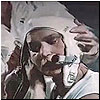 |
Roots of the "woman in space" project In June 1963, the USSR stunned the world with another space sensation -- 26-year-old Valentina Tereshkova, the first woman to orbit the Earth. Ironically, Tereshkova's stellar achievement might have been the result of a misunderstanding! The Soviet decision to put a woman in space was likely triggered by a widely publicized but unofficial push to train American female astronauts. |
|||||||||||||||||||||||||||||||||||||||||||||||||
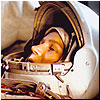 |
Women's space team starts training In March 1962, five young women -- Irina Solovieva, Valentina Tereshkova, Tatyana Kuznetsova, Zhanna Yerkina and Valentina Ponomareva -- were selected for an elite and top-secret training to become cosmonauts. When four of them "graduated" in November, key project officials had already singled out Tereshkova as the best candidate to become the first woman in space. |
|||||||||||||||||||||||||||||||||||||||||||||||||
 |
Tereshkova prepares to fly: A race behind the scene After months of fierce debates, Soviet planners agreed to prepare a dual manned mission: Vostok-5 would push the limits of the existing spacecraft attempting a record-breaking eight-day flight, while Vostok-6 would carry the first woman into space. Both spacecraft were to be launched from the same pad within 48 hours from each other. |
|||||||||||||||||||||||||||||||||||||||||||||||||
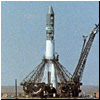 |
Vostok-5 delays: Burned by the Sun Originally scheduled for launch as early as June 3, 1963, the upcoming mission of Vostok-5 was plagued by problems. On June 10, when the rocket with the spacecraft had been already on the pad, a stark warning from astronomers about an imminent solar storm carrying dangerous radiation to the Earth's vicinity grounded the mission for several days. |
|||||||||||||||||||||||||||||||||||||||||||||||||
 |
Vostok-5 launch: On the knife's edge On June 14, 1963, after a nerve-wracking string of last-minute technical glitches, Vostok-5 finally lifted off at the very end of its launch window. As the Vostok entered orbit, the third stage of its rocket cut off and separated with a bang. Seconds after the world around him suddenly became weightless, Bykovsky watched snowflakes flying behind the window. |
|||||||||||||||||||||||||||||||||||||||||||||||||
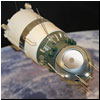 |
Vostok-5 in orbit: Almost flawless After its troubled launch, Vostok-5's orbital flight felt like a relief to ground controllers. Bykovsky not only stayed free of the ugly effects of weightlessness, but seemingly enjoyed it. However increased solar radiation caused the Earth atmosphere to "bulge" and increase friction with the spacecraft, threatening an unplanned reentry. An early return seemed to be the only option to avoid it. |
|||||||||||||||||||||||||||||||||||||||||||||||||
 |
Mission of Vostok-6: I am "Seagull" Disproving once again sailors' old myth about women onboard bringing bad luck, Tereshkova's launch was a "walk in the park" comparing to Bykovsky's trouble-plagued countdown. On June 16, Vostok-6 successfully entered orbit and the name of Valentina Tereshkova, along with her call sign "Seagull," was trumpeted around the world. |
|||||||||||||||||||||||||||||||||||||||||||||||||
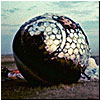 |
Vostok-6 landing: Real and imaginary ills With her place in history guaranteed, Tereshkova had an opportunity to land after just one day in orbit. Yet, mission control decided to "satisfy her wish" to complete a three-day mission. Until this day, her contemporaries disagree on her performance during the flight, but on June 19, 1963, Tereshkova successfully returned to Earth with just a scratch on her nose. |
|||||||||||||||||||||||||||||||||||||||||||||||||
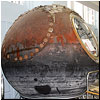 |
Vostok-5 landing: Without a hitch Soon after Tereshkova's touchdown, Gagarin called Bykovsky still orbiting the Earth saying, "Chaika ("Seagull") landed, it is now your turn." Keeping his cool all the way though, Bykovsky landed successfully after a record-breaking 119-hour and 6-minute mission, even after his flight was cut short. He holds the record for a longest flight by a single pilot until this day. |
|||||||||||||||||||||||||||||||||||||||||||||||||
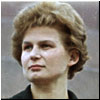 |
Aftermath of Tereshkova's mission: the triumph, rumors and controversy One June 22, 1963, Tereshkova and Bykovsky returned to Moscow to heroes' welcome. However behind the scene, Tereshkova's "failures" steered plenty of controversy in the secretive Soviet rocket industry. While her political career flourished, she never flew in space again and only two other Russian women could do the same in the next half a century! |
|||||||||||||||||||||||||||||||||||||||||||||||||
| OVERVIEW | ||||||||||||||||||||||||||||||||||||||||||||||||||
 |
Vostok-5 and 6 missions at a glance:
|
|||||||||||||||||||||||||||||||||||||||||||||||||
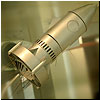 |
Facts and misconceptions As with many other Russian space achievements, the popular press often marks anniversaries of Tereshkova's mission with numerous... and erroneous stories. Below is the guide to the most popular myths and misconceptions:
Page author: Anatoly Zak; Last update: June 23, 2022 Page editor: Alain Chabot; Last edit: June 11, 2013 All rights reserved |
|||||||||||||||||||||||||||||||||||||||||||||||||